Media Effects Research Lab - Research Archive
How Social Networking Impacts One’s State of Mind
Student Researcher(s)
Veronica Matatov (B.A. Candidate);
Summer Ziernicki (B.A. Candidate);
Justin Resnik (B.A. Candidate);
Faculty Supervisor
This paper was based on a project as part of the COMM 418 course.
INTRODUCTION
With the rapid increase in users and traffic, many studies have been done on social media and its role in society. Although a wide variety of variables have been looked at, one thing appears consistent - social media’s impact on its users is extremely powerful. In order to dive deeper into the impact that social networking has on one’s frame of mind, our research study focuses on the three social media outlets that college students use most: Facebook, Twitter, and Instagram. Our study analyzes how college students’ use of social networking on these sites affects their temporary state of mind.
RESEARCH QUESTION / HYPOTHESES
RQ1: For college students, controlling for gender and age, what is the relationship between the number of friends/followers on social media platform and mood management?
RQ2: For college students, controlling for gender and age, what is the relationship between the number of followers on social media platform and satisfaction?
RQ3: For college students, controlling for gender and age, what is the relationship between the number of followers on social media platform and envy/jealousy?
RQ4: For college students, controlling for gender and age, what is the relationship between the number of followers on social media platform and lifestyle surveillance?
METHOD
We created an online survey using Google Forms and distributed it to undergraduate college students using a convenience sample. The sample consisted of 74 participants from ages 18-27. Of the participants 64.9% were female 35.1% were male. The average participant had 831 Instagram followers, 351 Twitter followers, and 1223 Facebook friends. The survey consisted of 10 questions and asked questions regarding demographics, the amount of time spent on social media, the amount of friends or followers they had on the social media platforms, and lastly, questions based on how social media affected their temporary state of mind. The independent variable was the amount of followers or friends on social media platform. Participants were asked to record the number of followers or friends they had from Facebook, Instagram, and Twitter. The dependent variables were the temporary effects that social media had on the participant’s states of mind. The temporary effects included change in mood, jealousy or envy, yearn to change lifestyle, and overall satisfaction. Each variable was measured using multiple choice questions that were answered based on the Likert scale.
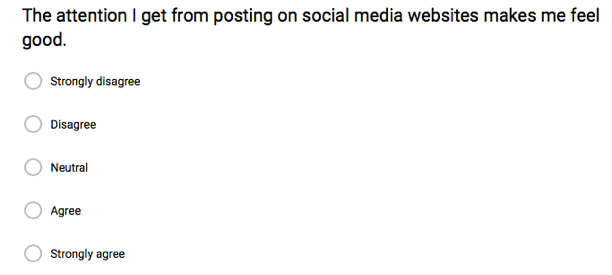
Figure 1. Sample Question
RESULTS
Our results suggest that the number of followers or friends on social media do not have a strong effect on one’s temporary mood. Although RQ1 and RQ2 had significant relationships present in regards to number of friends on Facebook and mood and number of followers on Instagram and satisfaction, the overall relationship was not strong due to their r’s being so low (RQ1: r =.0005, RQ2: r = .0004). Apart from those results, RQ3 and RQ4 displayed that, based on the data analyzed, there is no relationship between jealousy and envy or urge to change one’s lifestyle and number of followers or friends on social media platforms.
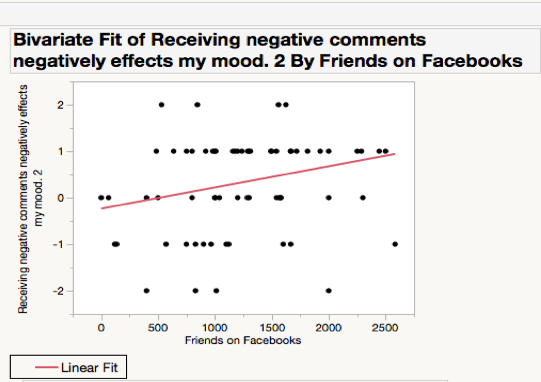
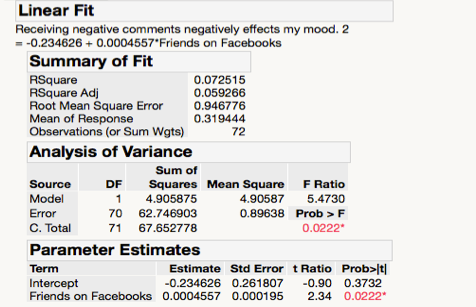
Figure 2. RQ1 Graph, RQ1 Results
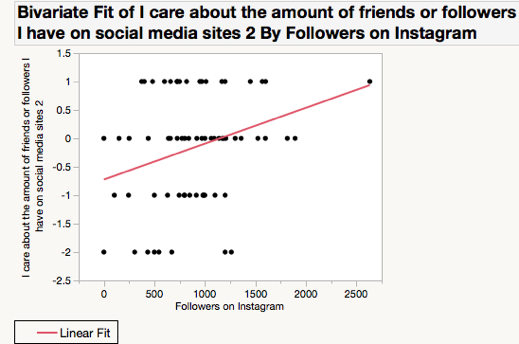
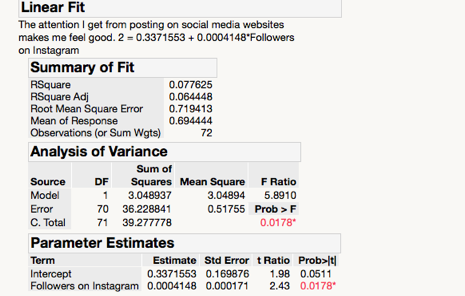
Figure 3. RQ2 Graph, RQ2 Results
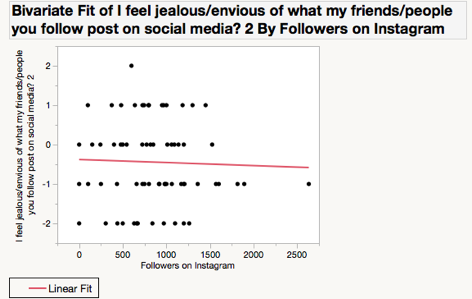
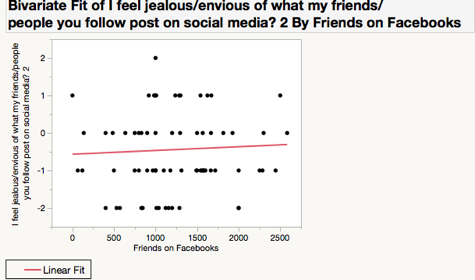
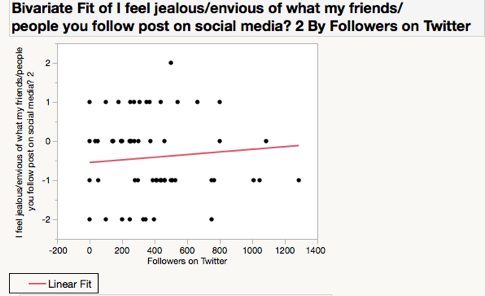
Figure 4. RQ3 Graph, RQ3 Results
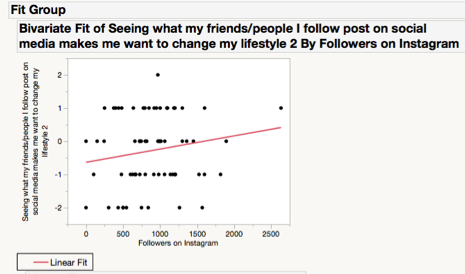
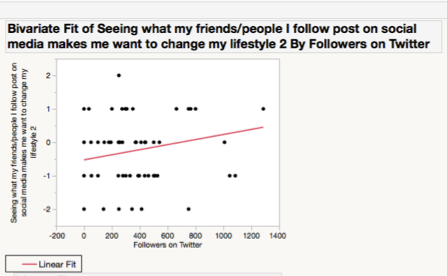
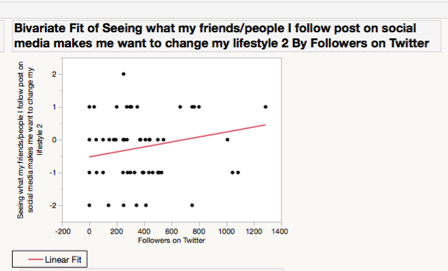
Figure 5. RQ4 Graph, RQ4 Result
CONCLUSION/DISCUSSIONS
We have concluded that number of friends on Facebook effects mood because Facebook creates intensified relationships through extensive content/media sharing. We attributed the relationship between Instagram and satisfaction to the “likes” people get from their followers which creates a great deal of validation, and subsequently a greater amount of satisfaction. As for the lack of relationship between number of friends/followers and jealousy/lifestyle surveillance, it is possible that the quality of friends/followers is more important than the quantity. Additionally, we have discovered that women are more active on social media because they tend to be more socially expressive, which translates into greater social media use.
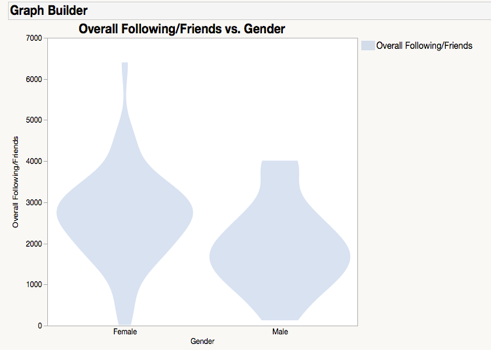
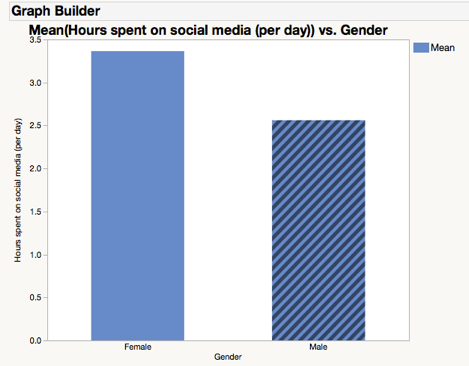
Figure 6. Female Social Media Use Graph
Throughout our research, we applied the theories of social exchange and social comparison. We have proposed that the practical implications of our study could apply to revising Facebook’s process for reporting negative/inappropriate content. We believe our research would also be of use to media buyers, who would benefit from knowing that college-aged females use social media more than males. We identified our limitations as a disproportionate gender sample (mostly females), self-reporting bias, and a small and unvaried sample demographic. For future research we would like to recreate the study using a more diverse sample, including adults, adolescents and people of different backgrounds. We would also be interested to understanding and testing the long-term effects that social media has on one’s state of mind.
For more details regarding the study contact
Dr. S. Shyam Sundar by e-mail at sss12@psu.edu or by telephone at (814) 865-2173

